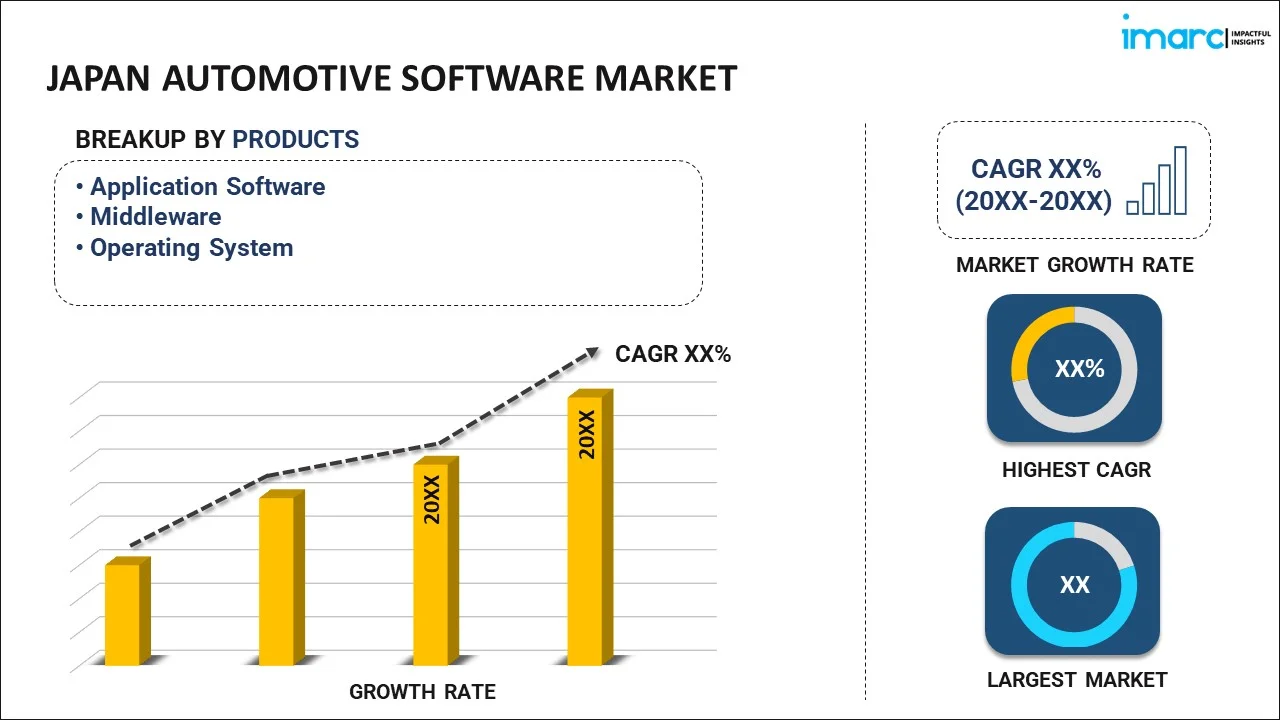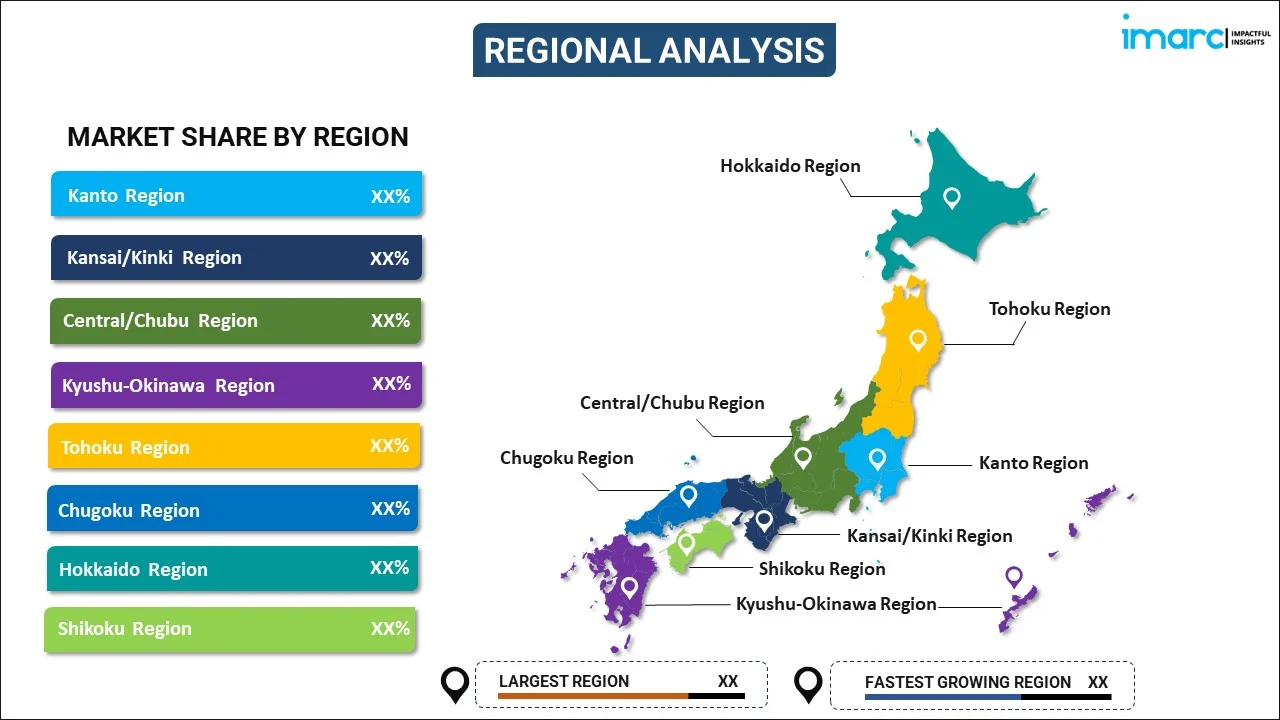
Japan Automotive Software Market Report by Product (Application Software, Middleware, Operating System), Vehicle Type (ICE Passenger Vehicle, ICE Light Commercial Vehicle, ICE Heavy Commercial Vehicle, Battery Electric Vehicle, Hybrid Electric Vehicle, Plug-in Hybrid Electric Vehicle, Autonomous Vehicles), Application (Safety and Security, Infotainment and Instrument Cluster, Vehicle Connectivity, and Others), and Region 2026-2034
Market Overview:
The Japan automotive software market size reached USD 1.2 Billion in 2025. Looking forward, IMARC Group expects the market to reach USD 4.0 Billion by 2034, exhibiting a growth rate (CAGR) of 14.39% during 2026-2034. The rising consumer demand for advanced vehicle features, especially in safety, efficiency, and connectivity, ongoing technological innovation and stringent government regulations across the country, represent some of the key factors driving the market.
|
Report Attribute
|
Key Statistics
|
|---|---|
|
Base Year
|
2025 |
|
Forecast Years
|
2026-2034
|
|
Historical Years
|
2020-2025
|
| Market Size in 2025 | USD 1.2 Billion |
| Market Forecast in 2034 | USD 4.0 Billion |
| Market Growth Rate (2026-2034) | 14.39% |
Access the full market insights report Request Sample
Automotive software refers to the digital programs and systems integrated within vehicles to enhance their functionality, safety, and user experience. This software encompasses a wide range of applications, from basic operating systems that manage vehicle hardware to advanced solutions for autonomous driving, connectivity, and infotainment. Key areas of automotive software include engine management systems, which optimize performance and fuel efficiency, and safety systems, like anti-lock braking and airbag deployment. The growing field of infotainment integrates navigation, multimedia, and connectivity features, offering a seamless and interactive experience for drivers and passengers. Telematics software also plays a vital role in real-time vehicle monitoring, offering insights into vehicle health, driving patterns, and maintenance needs. With the advent of electric and autonomous vehicles, automotive software is increasingly focusing on battery management, advanced driver-assistance systems (ADAS), and self-driving algorithms. These technologies rely heavily on software for data processing, decision-making, and ensuring safety and compliance with regulatory standards. At present, automotive software is gaining traction as a critical component, transforming the way vehicles operate, communicate, and interact with users and the environment.
Japan Automotive Software Market Trends:
The Japan automotive software market is experiencing significant growth, driven by a multitude of factors. One of the key drivers propelling the market growth includes rapid technological innovation. Japan, known for its technological prowess, is at the forefront of developing advanced automotive technologies. Apart from this, the global push toward electric vehicles (EVs) and autonomous driving is leading to a heightened demand for software for battery management systems in EVs and algorithms for autonomous vehicles, further fueling market growth. Additionally, the Japanese government’s stringent regulations and policies regarding vehicle safety and emissions are compelling automakers to integrate sophisticated software solutions. These regulations necessitate advanced engine management systems and emissions control software, driving market growth. Besides this, Japanese consumers have a strong preference for vehicles equipped with the latest technology, which is catalyzing the demand for advanced infotainment systems, connectivity features, and driver-assistance technologies, all of which rely heavily on software. Furthermore, Japan’s automotive industry, home to global giants like Toyota and Honda, is highly competitive. This competition fosters innovation, resulting in the development of cutting-edge automotive software solutions. In line with this, the increasing collaborations among automotive companies and tech firms in Japan facilitate the development of new software solutions and technologies, contributing to market growth. Moreover, the rising focus on safety and driving assistance technologies due to an aging population has augmented the demand for software solutions that offer advanced safety features and improve vehicle efficiency. Along with this, Japan’s role as a key player in the global automotive industry spurs the development of automotive software in the country, thus accelerating market growth.
Japan Automotive Software Market Segmentation:
IMARC Group provides an analysis of the key trends in each segment of the market, along with forecasts at the country level for 2026-2034. Our report has categorized the market based on product, vehicle type, and application.
Product Insights:

To get detailed segment analysis of this market Request Sample
- Application Software
- Middleware
- Operating System
The report has provided a detailed breakup and analysis of the market based on the product. This includes application software, middleware, and operating system.
Vehicle Type Insights:
- ICE Passenger Vehicle
- ICE Light Commercial Vehicle
- ICE Heavy Commercial Vehicle
- Battery Electric Vehicle
- Hybrid Electric Vehicle
- Plug-in Hybrid Electric Vehicle
- Autonomous Vehicles
A detailed breakup and analysis of the market based on the vehicle type have also been provided in the report. This includes ICE passenger vehicle, ICE light commercial vehicle, ICE heavy commercial vehicle, battery electric vehicle, hybrid electric vehicle, plug-in hybrid electric vehicle, and autonomous vehicles.
Application Insights:
- Safety and Security
- Infotainment and Instrument Cluster
- Vehicle Connectivity
- Others
The report has provided a detailed breakup and analysis of the market based on the application. This includes safety and security, infotainment and instrument cluster, vehicle connectivity, and others.
Regional Insights:

To get detailed regional analysis of this market Request Sample
- Kanto Region
- Kansai/Kinki Region
- Central/ Chubu Region
- Kyushu-Okinawa Region
- Tohoku Region
- Chugoku Region
- Hokkaido Region
- Shikoku Region
The report has also provided a comprehensive analysis of all the major regional markets, which include Kanto Region, Kansai/Kinki Region, Central/ Chubu Region, Kyushu-Okinawa Region, Tohoku Region, Chugoku Region, Hokkaido Region, and Shikoku Region.
Competitive Landscape:
The market research report has also provided a comprehensive analysis of the competitive landscape. Competitive analysis such as market structure, key player positioning, top winning strategies, competitive dashboard, and company evaluation quadrant has been covered in the report. Also, detailed profiles of all major companies have been provided.
Japan Automotive Software Market Report Coverage:
| Report Features | Details |
|---|---|
| Base Year of the Analysis | 2025 |
| Historical Period | 2020-2025 |
| Forecast Period | 2026-2034 |
| Units | Billion USD |
| Scope of the Report | Exploration of Historical Trends and Market Outlook, Industry Catalysts and Challenges, Segment-Wise Historical and Future Market Assessment:
|
| Products Covered | Application Software, Middleware, Operating System |
| Vehicle Types Covered | ICE Passenger Vehicle, ICE Light Commercial Vehicle, ICE Heavy Commercial Vehicle, Battery Electric Vehicle, Hybrid Electric Vehicle, Plug-in Hybrid Electric Vehicle, Autonomous Vehicles |
| Applications Covered | Safety and Security, Infotainment and Instrument Cluster, Vehicle Connectivity, Others |
| Regions Covered | Kanto Region, Kansai/Kinki Region, Central/ Chubu Region, Kyushu-Okinawa Region, Tohoku Region, Chugoku Region, Hokkaido Region, Shikoku Region |
| Customization Scope | 10% Free Customization |
| Post-Sale Analyst Support | 10-12 Weeks |
| Delivery Format | PDF and Excel through Email (We can also provide the editable version of the report in PPT/Word format on special request) |
Key Questions Answered in This Report:
- How has the Japan automotive software market performed so far and how will it perform in the coming years?
- What has been the impact of COVID-19 on the Japan automotive software market?
- What is the breakup of the Japan automotive software market on the basis of product?
- What is the breakup of the Japan automotive software market on the basis of vehicle type?
- What is the breakup of the Japan automotive software market on the basis of application?
- What are the various stages in the value chain of the Japan automotive software market?
- What are the key driving factors and challenges in the Japan automotive software?
- What is the structure of the Japan automotive software market and who are the key players?
- What is the degree of competition in the Japan automotive software market?
Key Benefits for Stakeholders:
- IMARC’s industry report offers a comprehensive quantitative analysis of various market segments, historical and current market trends, market forecasts, and dynamics of the Japan automotive software market from 2020-2034.
- The research report provides the latest information on the market drivers, challenges, and opportunities in the Japan automotive software market.
- Porter's five forces analysis assist stakeholders in assessing the impact of new entrants, competitive rivalry, supplier power, buyer power, and the threat of substitution. It helps stakeholders to analyze the level of competition within the Japan automotive software industry and its attractiveness.
- Competitive landscape allows stakeholders to understand their competitive environment and provides an insight into the current positions of key players in the market.
Need more help?
- Speak to our experienced analysts for insights on the current market scenarios.
- Include additional segments and countries to customize the report as per your requirement.
- Gain an unparalleled competitive advantage in your domain by understanding how to utilize the report and positively impacting your operations and revenue.
- For further assistance, please connect with our analysts.
 Request Customization
Request Customization
 Speak to an Analyst
Speak to an Analyst
 Request Brochure
Request Brochure
 Inquire Before Buying
Inquire Before Buying




.webp)




.webp)












